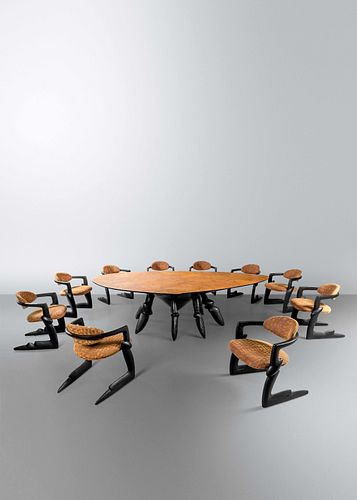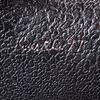Wendell Castle (1932-2018) Seven Days of the Week Dining Table and Ten Chairs, 1997
Lot 46
About Seller
Hindman
1338 West Lake Street
Chicago, IL 60607
United States
Recognized as the Midwest's leading fine art auctioneers, Hindman Auctioneers has built a worldwide reputation based on a full service approach to the auction business tailored to meet the individual needs of our clients. Coming from a variety of educational backgrounds, specialists bring years of e...Read more
Categories
Estimate:
$60,000 - $80,000
Absentee vs Live bid
Two ways to bid:
- Leave a max absentee bid and the platform will bid on your behalf up to your maximum bid during the live auction.
- Bid live during the auction and your bids will be submitted real-time to the auctioneer.
Bid Increments
| Price | Bid Increment |
|---|---|
| $0 | $25 |
| $500 | $50 |
| $1,000 | $100 |
| $2,000 | $250 |
| $5,000 | $500 |
| $10,000 | $1,000 |
| $20,000 | $2,500 |
| $50,000 | $5,000 |
| $100,000 | $10,000 |
About Auction
By Hindman
Mar 23, 2021
Set Reminder
2021-03-23 11:00:00
2021-03-23 11:00:00
America/New_York
Bidsquare
Bidsquare : The Springborn Collection of Contemporary Craft
https://www.bidsquare.com/auctions/hindman-auctions/the-springborn-collection-of-contemporary-craft-6453
Hindman Bidsquare@hindmanauctions.com
Hindman Bidsquare@hindmanauctions.com
- Lot Description
Wendell Castle
(1932-2018)
Seven Days of the Week Dining Table and Ten Chairs, 1997
ebonized mahogany, ash veneer, upholstery
signed 'Castle 97'
Table | H 29 x W 110 x D 66 inches, Chair | H 28 x W 24 x D 22 inches
Exhibited:
"Wendell Castle" Bryan Ohno Gallery, Seattle, WA, October 2-November 8, 1997
"Living with Studio Furniture: Collection of Robert and Carolyn Springborn" Naples Museum of Art, Naples, FL, January 16-June 28, 2009
Literature:
Naples Museum of Art, Living with Studio Furniture: Collection of Robert and Carolyn Springborn, exh. cat., Naples, 2009, illustrated p. 14, 24 Emily Evans Eerdmans, Wendell Castle, A Catalogue Raisonne 1958-2012, New York, 2014, illustrated p. 328, 366
Lot Essay:
As furniture forms go, dining tables are hard to get right: a horizontal expanse that hides the undercarriage from view, surrounded by a set of chairs further prevents the table from making a statement. Yet the dining table is also one of the most important pieces of furniture in a home, a social object, around which conversation, family and friendship form.
Wendell Castle, never one to shy from a challenge, returned to the typology often. He first tackled it in 1966, making three similar dining tables in walnut, one for his own use. All featured an ingenious means of opening up the form: a central aperture yielding a view down to a sculpted pedestal. These works exploit Castle’s signature stack lamination technique, which freed him from conventional joinery and allowed him to compose freely in space.
Four decades later he returned to this idea for a dining table that he nicknamed the “hole in one.” (It was made for the 2015 exhibition Wendell Castle Remastered, at the Museum of Arts and Design.) It sports a triad of conical supports, the tallest seven feet high, and a top that extends outward in a long cantilever. The design was achieved with CNC carving, which Castle employed to hollow out the wooden top, then filling it with hard light foam, and overlaying a veneer. The result is a featherlight shape that extends breathtakingly into midair.
Right at the midpoint between these two moments, in 1997, Castle created his Seven Days of the Week suite for the Springborns. He was on an impressive run, having just realized his monumental Star Cabinets (shown to great advantage at Peter Joseph Gallery in 1995). The strong organic silhouette of these designs is reprised in a more articulated form in the Seven Days pieces, all of which have legs suggestive of an arthropod’s. In the dining table, the legs stage a vivid contrast with the smooth asymmetrical top, recalling midcentury biomorphic designs by Isamu Noguchi.
The accompanying chairs feature continuous frames, running along the floor, up, around, and back again. Castle made many variations on this low-slung format enacts a sort of visual lean, yielding pride of place to the majestic table and its sculptural base. Yet another wholly original solution, from a wholly original designer.
-Glenn Adamson
Property from the Collection of Dr. Robert C. Springborn and Mrs. Carolyn J. Springborn, Naples, FloridaCondition
For condition inquiries please contact moderndesigncr@hindmanauctions.com - Shipping Info
-
Please refer to https://hindmanauctions.com/shipping-packing
-
- Buyer's Premium



 EUR
EUR CAD
CAD AUD
AUD GBP
GBP MXN
MXN HKD
HKD CNY
CNY MYR
MYR SEK
SEK SGD
SGD CHF
CHF THB
THB



















